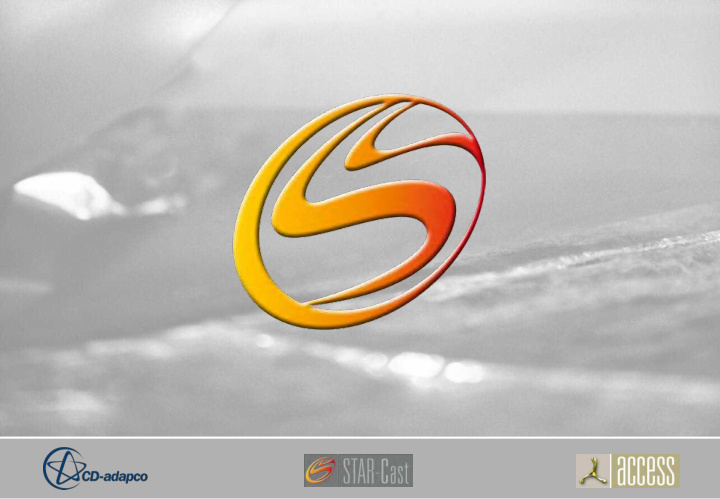



Simulation of High Pressure Die Casting (HPDC) via STAR-Cast STAR Global Conf. 2012, 19-21 March, Noordwijk Romuald Laqua, Access e.V., Aachen
High Pressure Die Casting: Machines and Products Common Materials: ● Aluminum alloys ● Magnesium alloys ● Zinc alloys ● Copper alloys
HPDC process cycle, horizontal cold chamber machine Parts considered for simulation
HPDC process cycle: 1. closing moving die parts
HPDC process cycle: 2. shot sleeve filled with melt, starting plunger movement
HPDC process cycle: 3. completed shot
HPDC process cycle: 4. ejecting and removing solidified casting
HPDC process cycle: 5. spraying of lubricant, casting cycle finished
Challenges in HPDC Simulation: Moving plunger in filling chamber – moving mesh model necessary Thin walled, complicated and large castings – challenging enmeshment and high cell count Multi physics: melt, solid, gas – VoF model with HRIC scheme, combined with surface tension model and correct wetting angle Short pouring times, leading to high fluid velocities – small time steps (~0.1ms) mandatory Extreme pressure ranges from 10 Pa initial cavity pressure up to 1000 bar in melt during solidification – Compressibility model for melt and gas
Why simulate? Goals & Objectives of HPDC Simulation: Reduce iterations in tooling development: Cost for one mould insert 50-100k € Reduce process development time: faster achievement of a stable process window Better process understanding: helpful when negotiate with customers about necessary part design changes Typical defects in high pressure die casting: Misruns: Melt solidifies before filling is completed Cold shuts: Imperfect fusing of molten metal coming together from opposite directions in a mold Porosity: small holes caused by insufficient feeding or dissolved gas Air and oxides inclusions Cold flakes: floating crystals, solidified at shot sleeve walls and transported into cast part
High Pressure Die Casting – Overview Features ● Filling Simulation ● Gas is Compressible ● Liquid is Compressible ● Moving Mesh ● Phase Change ● Conjugate Heat Transfer Simulation ● Shot chamber is half filled with liquid, plunger follows shot control curve, pushing the fluid into the cavity
High Pressure Die Casting: shot curve v Plunger =f(t) Constant velocity until mold is filled, followed by pressure control, up to 1000 bar
High Pressure Die Casting – Geometry and Mesh Cast Chilled vents Shot sleeve (allow air to escape and force melt to freeze) Die parts
Meshing Polyhedral mesh in cast part and die Cell count: 1.6 million cells in fluid domains 3.6 million cells overall Structured (extruded) mesh in shot sleeve
Meshing ● Two layers of prism cells on each side of casting-die interfaces to resolve high temperature gradients ● Water and oil channels are not meshed
Process parameter setup, additional settings related to HPDC process Shot sleeve components must be identified: Empty filling chamber Prefilled with melt Shot sleeve walls
Process parameter setup Shot curve definition: Enter values or read from file
Process parameter setup Pressure curve definition: Enter values or read from file
Die cycle warm up simulation Pure thermal simulation over at least 5 casting cycles, including all phases: shot, solidification, die opening, ejection and spraying Final temperature distribution in die is used as initial state for main simulation run with coupled filling and solidification
Initial temperatures in die and shot sleeve Cooling cycles in oil and water channels are modelled by applying mean fluid temperatures on channel wall boundaries (channels are not part of computational domain)
High Pressure Die Casting – Results Pressure on melt surface Time = 1.96 seconds Time = 2.05 seconds Time = 2.06 seconds Velocity on melt surface
Temperature distribution on melt surface during mold filling Front view Rear view
Air entrappments in casting after completed shot (2.52 s) Initial melt temperature = 680°C Initial melt temperature = 640°C
Animated mold filling process with piston movement Initial melt temperature = 680°C T liquidus = 613°C T solidus = 555°C
Future steps of development of STAR-Cast HPDC process is challenging to simulate seriously, but casting industry seeks for a more detailed simulation tool with more physics inside Migration to STAR-CCM+ will simplify the setup process, enhance postprocessing capabilities and (probably) improve numerical stability
Recommend
More recommend